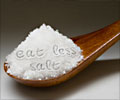Educating family members of heart failure (HF) patients about the health benefits of consuming a low-salt diet and providing skills for support and communication can effectively
Educating family members of heart failure (HF) patients about the health benefits of consuming a low-salt diet and providing skills for support and communication can effectively reduce HF patients’ sodium consumption, according to an interdisciplinary study led by Emory University cardiovascular nursing researcher Sandra Dunbar, RN, DSN, FAAN, FAHA.
Dunbar will present key findings of this study today at the annual meeting of the American Heart Association in Orlando."Greater efforts are needed to incorporate and optimize family-focused education and support interventions into heart failure care," says Dunbar, Charles Howard Candler professor of nursing at Emory’s Nell Hodgson Woodruff School of Nursing. "Although usual care in these facilities is very strong in terms of patient education, family members may not be systematically included. Family members can play an important role in motivating and supporting the person with heart failure."
Heart failure patients and a family member were randomized to receive patient and family education (PFE), or family partnership intervention (FPI) or usual care. The PFE or education group included in-depth education on diet selection and preparation, label reading and selecting low-sodium foods. The family partnership or FPI intervention added knowledge and skills of family support communication, collaboration and empathy using autonomy support concepts.
Heart patients were 64 percent men, average age 56 years, and 58 percent African American with average ventricular ejection fraction of 26.9 with optimally prescribed heart failure medications. Family members were 81 percent female, average age 52 years, with 53 percent being spouses.
Dunbar and team measured dietary salt intake by 24-hour urinary sodium excretion and analyzed a three-day food record with a nutrient software program at baseline, four and eight months:
- At baseline, the groups didn’t differ on demographic, clinical, diet or urinary sodium.
- At four months, the FPI group had significantly decreased urinary sodium from baseline and differed from those in usual care.
- At eight months, the PFE group had lower on average urinary sodium than usual care. However, over time the PFE and FPI groups didn’t differ.
- The proportion of subjects that met the urinary sodium criterion of less than 2500 milligrams per day at eight months was higher in the intervention groups with 54 percent of FPI group and 53 percent of the PFE group meeting that goal compared to the usual care group. Only 25 percent of usual care patients met that goal. Advertisement
Source-Eurekalert
TAN















